Obesity in Australia: A Need for Urgent Action
VerifiedAdded on 2021/05/31
|14
|3972
|176
AI Summary
Contribute Materials
Your contribution can guide someone’s learning journey. Share your
documents today.

Running Head: POLICY ANALYSIS OF CHAPTER 2 (OBESITY IN AUSTRALIA: A NEED
FOR URGENT ACTION) OF THE NATIONAL PREVENTATIVE HEALTH STRATEGY–
THE ROADMAP FOR ACTION
Policy Analysis of Chapter 2 (Obesity in Australia: A Need for Urgent Action) of the National
Preventative Health Strategy–The Roadmap for Action
Student’s Name
Institutional Affiliation
Instructor
FOR URGENT ACTION) OF THE NATIONAL PREVENTATIVE HEALTH STRATEGY–
THE ROADMAP FOR ACTION
Policy Analysis of Chapter 2 (Obesity in Australia: A Need for Urgent Action) of the National
Preventative Health Strategy–The Roadmap for Action
Student’s Name
Institutional Affiliation
Instructor
Secure Best Marks with AI Grader
Need help grading? Try our AI Grader for instant feedback on your assignments.
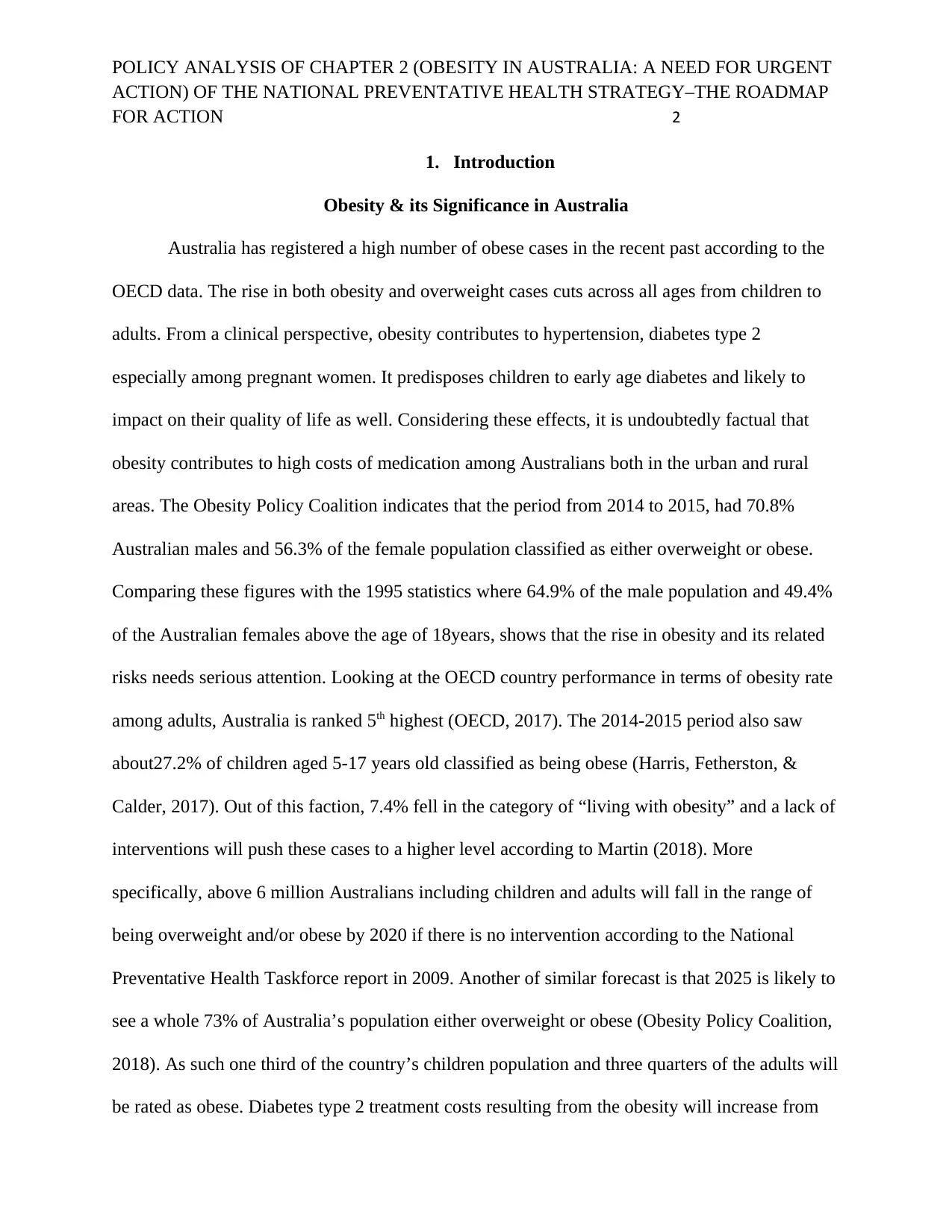
POLICY ANALYSIS OF CHAPTER 2 (OBESITY IN AUSTRALIA: A NEED FOR URGENT
ACTION) OF THE NATIONAL PREVENTATIVE HEALTH STRATEGY–THE ROADMAP
FOR ACTION 2
1. Introduction
Obesity & its Significance in Australia
Australia has registered a high number of obese cases in the recent past according to the
OECD data. The rise in both obesity and overweight cases cuts across all ages from children to
adults. From a clinical perspective, obesity contributes to hypertension, diabetes type 2
especially among pregnant women. It predisposes children to early age diabetes and likely to
impact on their quality of life as well. Considering these effects, it is undoubtedly factual that
obesity contributes to high costs of medication among Australians both in the urban and rural
areas. The Obesity Policy Coalition indicates that the period from 2014 to 2015, had 70.8%
Australian males and 56.3% of the female population classified as either overweight or obese.
Comparing these figures with the 1995 statistics where 64.9% of the male population and 49.4%
of the Australian females above the age of 18years, shows that the rise in obesity and its related
risks needs serious attention. Looking at the OECD country performance in terms of obesity rate
among adults, Australia is ranked 5th highest (OECD, 2017). The 2014-2015 period also saw
about27.2% of children aged 5-17 years old classified as being obese (Harris, Fetherston, &
Calder, 2017). Out of this faction, 7.4% fell in the category of “living with obesity” and a lack of
interventions will push these cases to a higher level according to Martin (2018). More
specifically, above 6 million Australians including children and adults will fall in the range of
being overweight and/or obese by 2020 if there is no intervention according to the National
Preventative Health Taskforce report in 2009. Another of similar forecast is that 2025 is likely to
see a whole 73% of Australia’s population either overweight or obese (Obesity Policy Coalition,
2018). As such one third of the country’s children population and three quarters of the adults will
be rated as obese. Diabetes type 2 treatment costs resulting from the obesity will increase from
ACTION) OF THE NATIONAL PREVENTATIVE HEALTH STRATEGY–THE ROADMAP
FOR ACTION 2
1. Introduction
Obesity & its Significance in Australia
Australia has registered a high number of obese cases in the recent past according to the
OECD data. The rise in both obesity and overweight cases cuts across all ages from children to
adults. From a clinical perspective, obesity contributes to hypertension, diabetes type 2
especially among pregnant women. It predisposes children to early age diabetes and likely to
impact on their quality of life as well. Considering these effects, it is undoubtedly factual that
obesity contributes to high costs of medication among Australians both in the urban and rural
areas. The Obesity Policy Coalition indicates that the period from 2014 to 2015, had 70.8%
Australian males and 56.3% of the female population classified as either overweight or obese.
Comparing these figures with the 1995 statistics where 64.9% of the male population and 49.4%
of the Australian females above the age of 18years, shows that the rise in obesity and its related
risks needs serious attention. Looking at the OECD country performance in terms of obesity rate
among adults, Australia is ranked 5th highest (OECD, 2017). The 2014-2015 period also saw
about27.2% of children aged 5-17 years old classified as being obese (Harris, Fetherston, &
Calder, 2017). Out of this faction, 7.4% fell in the category of “living with obesity” and a lack of
interventions will push these cases to a higher level according to Martin (2018). More
specifically, above 6 million Australians including children and adults will fall in the range of
being overweight and/or obese by 2020 if there is no intervention according to the National
Preventative Health Taskforce report in 2009. Another of similar forecast is that 2025 is likely to
see a whole 73% of Australia’s population either overweight or obese (Obesity Policy Coalition,
2018). As such one third of the country’s children population and three quarters of the adults will
be rated as obese. Diabetes type 2 treatment costs resulting from the obesity will increase from
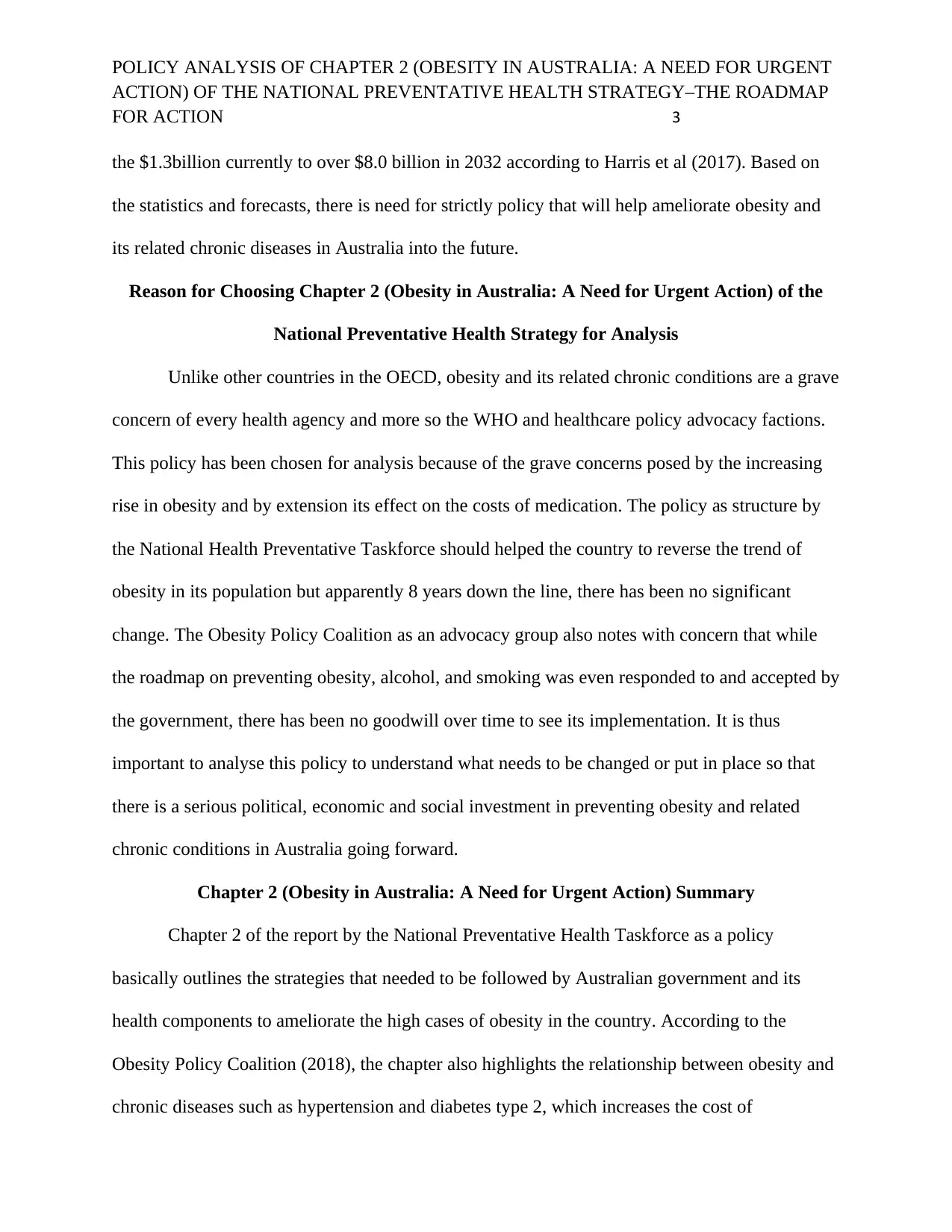
POLICY ANALYSIS OF CHAPTER 2 (OBESITY IN AUSTRALIA: A NEED FOR URGENT
ACTION) OF THE NATIONAL PREVENTATIVE HEALTH STRATEGY–THE ROADMAP
FOR ACTION 3
the $1.3billion currently to over $8.0 billion in 2032 according to Harris et al (2017). Based on
the statistics and forecasts, there is need for strictly policy that will help ameliorate obesity and
its related chronic diseases in Australia into the future.
Reason for Choosing Chapter 2 (Obesity in Australia: A Need for Urgent Action) of the
National Preventative Health Strategy for Analysis
Unlike other countries in the OECD, obesity and its related chronic conditions are a grave
concern of every health agency and more so the WHO and healthcare policy advocacy factions.
This policy has been chosen for analysis because of the grave concerns posed by the increasing
rise in obesity and by extension its effect on the costs of medication. The policy as structure by
the National Health Preventative Taskforce should helped the country to reverse the trend of
obesity in its population but apparently 8 years down the line, there has been no significant
change. The Obesity Policy Coalition as an advocacy group also notes with concern that while
the roadmap on preventing obesity, alcohol, and smoking was even responded to and accepted by
the government, there has been no goodwill over time to see its implementation. It is thus
important to analyse this policy to understand what needs to be changed or put in place so that
there is a serious political, economic and social investment in preventing obesity and related
chronic conditions in Australia going forward.
Chapter 2 (Obesity in Australia: A Need for Urgent Action) Summary
Chapter 2 of the report by the National Preventative Health Taskforce as a policy
basically outlines the strategies that needed to be followed by Australian government and its
health components to ameliorate the high cases of obesity in the country. According to the
Obesity Policy Coalition (2018), the chapter also highlights the relationship between obesity and
chronic diseases such as hypertension and diabetes type 2, which increases the cost of
ACTION) OF THE NATIONAL PREVENTATIVE HEALTH STRATEGY–THE ROADMAP
FOR ACTION 3
the $1.3billion currently to over $8.0 billion in 2032 according to Harris et al (2017). Based on
the statistics and forecasts, there is need for strictly policy that will help ameliorate obesity and
its related chronic diseases in Australia into the future.
Reason for Choosing Chapter 2 (Obesity in Australia: A Need for Urgent Action) of the
National Preventative Health Strategy for Analysis
Unlike other countries in the OECD, obesity and its related chronic conditions are a grave
concern of every health agency and more so the WHO and healthcare policy advocacy factions.
This policy has been chosen for analysis because of the grave concerns posed by the increasing
rise in obesity and by extension its effect on the costs of medication. The policy as structure by
the National Health Preventative Taskforce should helped the country to reverse the trend of
obesity in its population but apparently 8 years down the line, there has been no significant
change. The Obesity Policy Coalition as an advocacy group also notes with concern that while
the roadmap on preventing obesity, alcohol, and smoking was even responded to and accepted by
the government, there has been no goodwill over time to see its implementation. It is thus
important to analyse this policy to understand what needs to be changed or put in place so that
there is a serious political, economic and social investment in preventing obesity and related
chronic conditions in Australia going forward.
Chapter 2 (Obesity in Australia: A Need for Urgent Action) Summary
Chapter 2 of the report by the National Preventative Health Taskforce as a policy
basically outlines the strategies that needed to be followed by Australian government and its
health components to ameliorate the high cases of obesity in the country. According to the
Obesity Policy Coalition (2018), the chapter also highlights the relationship between obesity and
chronic diseases such as hypertension and diabetes type 2, which increases the cost of
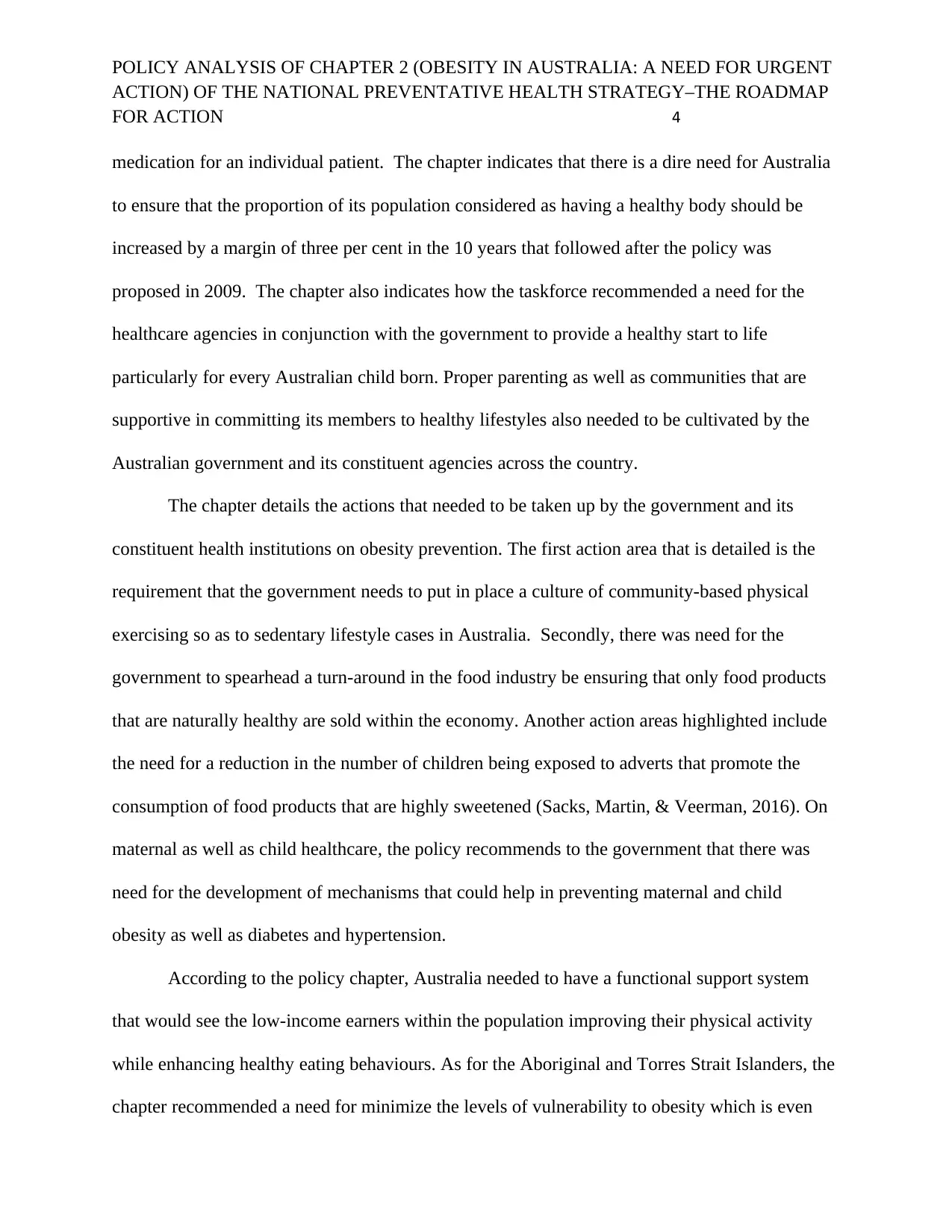
POLICY ANALYSIS OF CHAPTER 2 (OBESITY IN AUSTRALIA: A NEED FOR URGENT
ACTION) OF THE NATIONAL PREVENTATIVE HEALTH STRATEGY–THE ROADMAP
FOR ACTION 4
medication for an individual patient. The chapter indicates that there is a dire need for Australia
to ensure that the proportion of its population considered as having a healthy body should be
increased by a margin of three per cent in the 10 years that followed after the policy was
proposed in 2009. The chapter also indicates how the taskforce recommended a need for the
healthcare agencies in conjunction with the government to provide a healthy start to life
particularly for every Australian child born. Proper parenting as well as communities that are
supportive in committing its members to healthy lifestyles also needed to be cultivated by the
Australian government and its constituent agencies across the country.
The chapter details the actions that needed to be taken up by the government and its
constituent health institutions on obesity prevention. The first action area that is detailed is the
requirement that the government needs to put in place a culture of community-based physical
exercising so as to sedentary lifestyle cases in Australia. Secondly, there was need for the
government to spearhead a turn-around in the food industry be ensuring that only food products
that are naturally healthy are sold within the economy. Another action areas highlighted include
the need for a reduction in the number of children being exposed to adverts that promote the
consumption of food products that are highly sweetened (Sacks, Martin, & Veerman, 2016). On
maternal as well as child healthcare, the policy recommends to the government that there was
need for the development of mechanisms that could help in preventing maternal and child
obesity as well as diabetes and hypertension.
According to the policy chapter, Australia needed to have a functional support system
that would see the low-income earners within the population improving their physical activity
while enhancing healthy eating behaviours. As for the Aboriginal and Torres Strait Islanders, the
chapter recommended a need for minimize the levels of vulnerability to obesity which is even
ACTION) OF THE NATIONAL PREVENTATIVE HEALTH STRATEGY–THE ROADMAP
FOR ACTION 4
medication for an individual patient. The chapter indicates that there is a dire need for Australia
to ensure that the proportion of its population considered as having a healthy body should be
increased by a margin of three per cent in the 10 years that followed after the policy was
proposed in 2009. The chapter also indicates how the taskforce recommended a need for the
healthcare agencies in conjunction with the government to provide a healthy start to life
particularly for every Australian child born. Proper parenting as well as communities that are
supportive in committing its members to healthy lifestyles also needed to be cultivated by the
Australian government and its constituent agencies across the country.
The chapter details the actions that needed to be taken up by the government and its
constituent health institutions on obesity prevention. The first action area that is detailed is the
requirement that the government needs to put in place a culture of community-based physical
exercising so as to sedentary lifestyle cases in Australia. Secondly, there was need for the
government to spearhead a turn-around in the food industry be ensuring that only food products
that are naturally healthy are sold within the economy. Another action areas highlighted include
the need for a reduction in the number of children being exposed to adverts that promote the
consumption of food products that are highly sweetened (Sacks, Martin, & Veerman, 2016). On
maternal as well as child healthcare, the policy recommends to the government that there was
need for the development of mechanisms that could help in preventing maternal and child
obesity as well as diabetes and hypertension.
According to the policy chapter, Australia needed to have a functional support system
that would see the low-income earners within the population improving their physical activity
while enhancing healthy eating behaviours. As for the Aboriginal and Torres Strait Islanders, the
chapter recommended a need for minimize the levels of vulnerability to obesity which is even
Secure Best Marks with AI Grader
Need help grading? Try our AI Grader for instant feedback on your assignments.
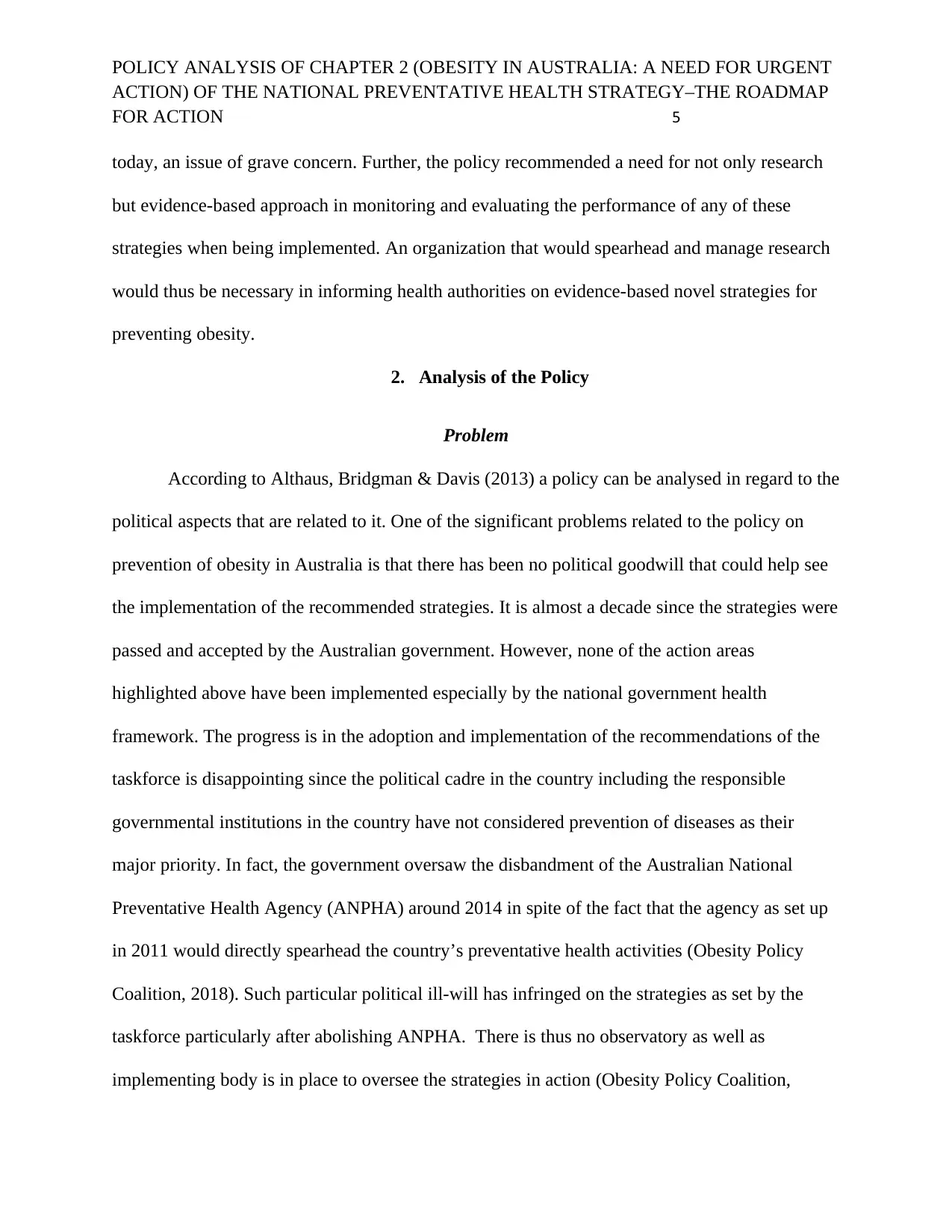
POLICY ANALYSIS OF CHAPTER 2 (OBESITY IN AUSTRALIA: A NEED FOR URGENT
ACTION) OF THE NATIONAL PREVENTATIVE HEALTH STRATEGY–THE ROADMAP
FOR ACTION 5
today, an issue of grave concern. Further, the policy recommended a need for not only research
but evidence-based approach in monitoring and evaluating the performance of any of these
strategies when being implemented. An organization that would spearhead and manage research
would thus be necessary in informing health authorities on evidence-based novel strategies for
preventing obesity.
2. Analysis of the Policy
Problem
According to Althaus, Bridgman & Davis (2013) a policy can be analysed in regard to the
political aspects that are related to it. One of the significant problems related to the policy on
prevention of obesity in Australia is that there has been no political goodwill that could help see
the implementation of the recommended strategies. It is almost a decade since the strategies were
passed and accepted by the Australian government. However, none of the action areas
highlighted above have been implemented especially by the national government health
framework. The progress is in the adoption and implementation of the recommendations of the
taskforce is disappointing since the political cadre in the country including the responsible
governmental institutions in the country have not considered prevention of diseases as their
major priority. In fact, the government oversaw the disbandment of the Australian National
Preventative Health Agency (ANPHA) around 2014 in spite of the fact that the agency as set up
in 2011 would directly spearhead the country’s preventative health activities (Obesity Policy
Coalition, 2018). Such particular political ill-will has infringed on the strategies as set by the
taskforce particularly after abolishing ANPHA. There is thus no observatory as well as
implementing body is in place to oversee the strategies in action (Obesity Policy Coalition,
ACTION) OF THE NATIONAL PREVENTATIVE HEALTH STRATEGY–THE ROADMAP
FOR ACTION 5
today, an issue of grave concern. Further, the policy recommended a need for not only research
but evidence-based approach in monitoring and evaluating the performance of any of these
strategies when being implemented. An organization that would spearhead and manage research
would thus be necessary in informing health authorities on evidence-based novel strategies for
preventing obesity.
2. Analysis of the Policy
Problem
According to Althaus, Bridgman & Davis (2013) a policy can be analysed in regard to the
political aspects that are related to it. One of the significant problems related to the policy on
prevention of obesity in Australia is that there has been no political goodwill that could help see
the implementation of the recommended strategies. It is almost a decade since the strategies were
passed and accepted by the Australian government. However, none of the action areas
highlighted above have been implemented especially by the national government health
framework. The progress is in the adoption and implementation of the recommendations of the
taskforce is disappointing since the political cadre in the country including the responsible
governmental institutions in the country have not considered prevention of diseases as their
major priority. In fact, the government oversaw the disbandment of the Australian National
Preventative Health Agency (ANPHA) around 2014 in spite of the fact that the agency as set up
in 2011 would directly spearhead the country’s preventative health activities (Obesity Policy
Coalition, 2018). Such particular political ill-will has infringed on the strategies as set by the
taskforce particularly after abolishing ANPHA. There is thus no observatory as well as
implementing body is in place to oversee the strategies in action (Obesity Policy Coalition,
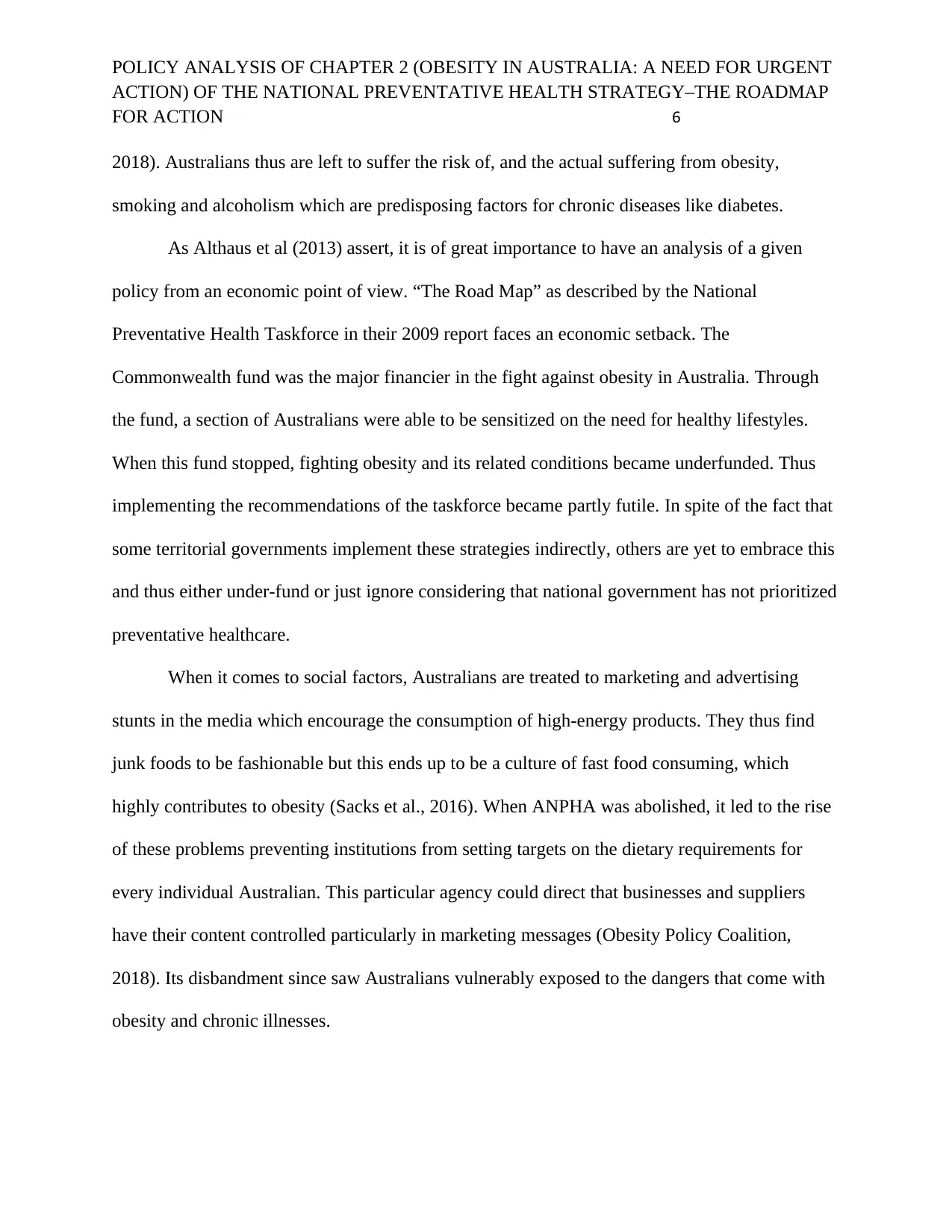
POLICY ANALYSIS OF CHAPTER 2 (OBESITY IN AUSTRALIA: A NEED FOR URGENT
ACTION) OF THE NATIONAL PREVENTATIVE HEALTH STRATEGY–THE ROADMAP
FOR ACTION 6
2018). Australians thus are left to suffer the risk of, and the actual suffering from obesity,
smoking and alcoholism which are predisposing factors for chronic diseases like diabetes.
As Althaus et al (2013) assert, it is of great importance to have an analysis of a given
policy from an economic point of view. “The Road Map” as described by the National
Preventative Health Taskforce in their 2009 report faces an economic setback. The
Commonwealth fund was the major financier in the fight against obesity in Australia. Through
the fund, a section of Australians were able to be sensitized on the need for healthy lifestyles.
When this fund stopped, fighting obesity and its related conditions became underfunded. Thus
implementing the recommendations of the taskforce became partly futile. In spite of the fact that
some territorial governments implement these strategies indirectly, others are yet to embrace this
and thus either under-fund or just ignore considering that national government has not prioritized
preventative healthcare.
When it comes to social factors, Australians are treated to marketing and advertising
stunts in the media which encourage the consumption of high-energy products. They thus find
junk foods to be fashionable but this ends up to be a culture of fast food consuming, which
highly contributes to obesity (Sacks et al., 2016). When ANPHA was abolished, it led to the rise
of these problems preventing institutions from setting targets on the dietary requirements for
every individual Australian. This particular agency could direct that businesses and suppliers
have their content controlled particularly in marketing messages (Obesity Policy Coalition,
2018). Its disbandment since saw Australians vulnerably exposed to the dangers that come with
obesity and chronic illnesses.
ACTION) OF THE NATIONAL PREVENTATIVE HEALTH STRATEGY–THE ROADMAP
FOR ACTION 6
2018). Australians thus are left to suffer the risk of, and the actual suffering from obesity,
smoking and alcoholism which are predisposing factors for chronic diseases like diabetes.
As Althaus et al (2013) assert, it is of great importance to have an analysis of a given
policy from an economic point of view. “The Road Map” as described by the National
Preventative Health Taskforce in their 2009 report faces an economic setback. The
Commonwealth fund was the major financier in the fight against obesity in Australia. Through
the fund, a section of Australians were able to be sensitized on the need for healthy lifestyles.
When this fund stopped, fighting obesity and its related conditions became underfunded. Thus
implementing the recommendations of the taskforce became partly futile. In spite of the fact that
some territorial governments implement these strategies indirectly, others are yet to embrace this
and thus either under-fund or just ignore considering that national government has not prioritized
preventative healthcare.
When it comes to social factors, Australians are treated to marketing and advertising
stunts in the media which encourage the consumption of high-energy products. They thus find
junk foods to be fashionable but this ends up to be a culture of fast food consuming, which
highly contributes to obesity (Sacks et al., 2016). When ANPHA was abolished, it led to the rise
of these problems preventing institutions from setting targets on the dietary requirements for
every individual Australian. This particular agency could direct that businesses and suppliers
have their content controlled particularly in marketing messages (Obesity Policy Coalition,
2018). Its disbandment since saw Australians vulnerably exposed to the dangers that come with
obesity and chronic illnesses.
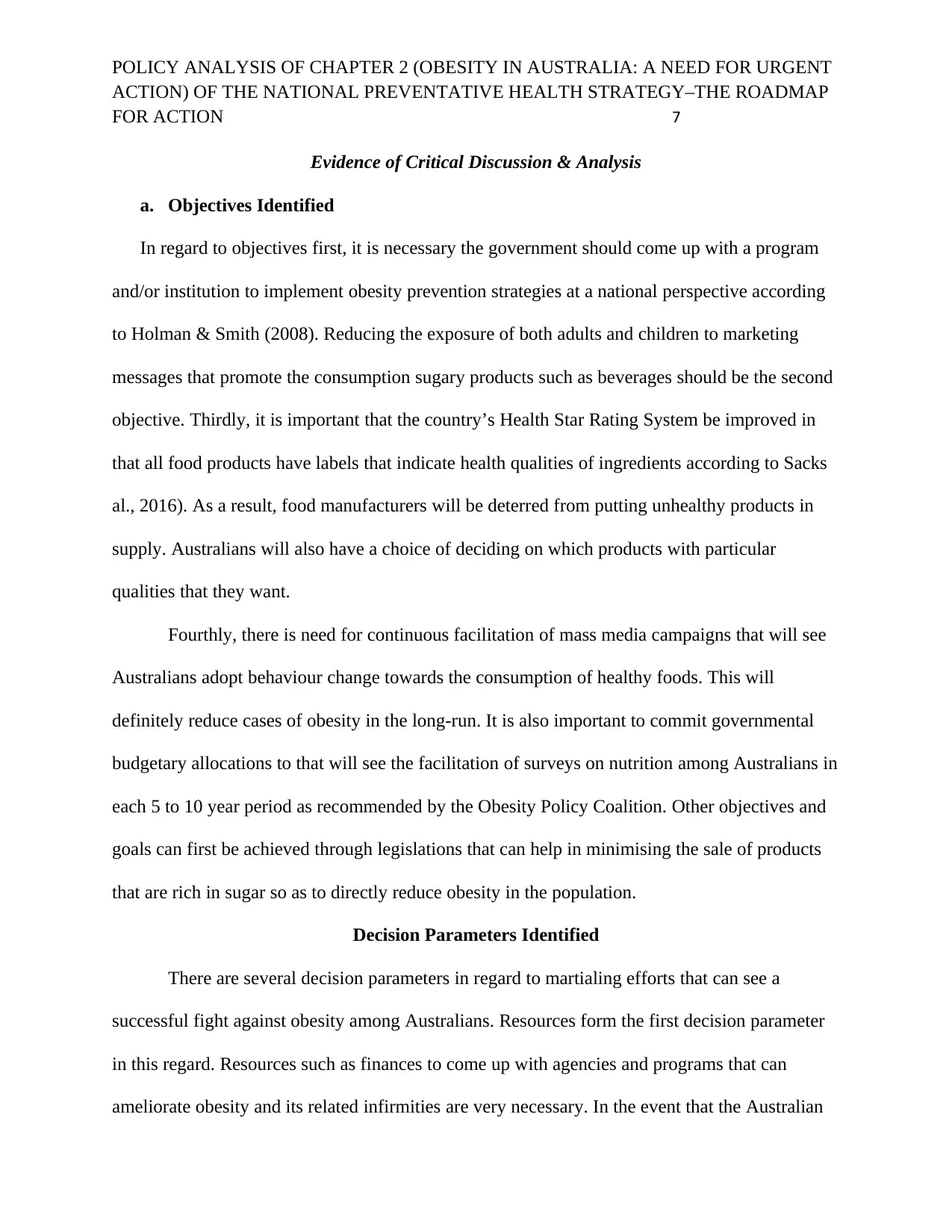
POLICY ANALYSIS OF CHAPTER 2 (OBESITY IN AUSTRALIA: A NEED FOR URGENT
ACTION) OF THE NATIONAL PREVENTATIVE HEALTH STRATEGY–THE ROADMAP
FOR ACTION 7
Evidence of Critical Discussion & Analysis
a. Objectives Identified
In regard to objectives first, it is necessary the government should come up with a program
and/or institution to implement obesity prevention strategies at a national perspective according
to Holman & Smith (2008). Reducing the exposure of both adults and children to marketing
messages that promote the consumption sugary products such as beverages should be the second
objective. Thirdly, it is important that the country’s Health Star Rating System be improved in
that all food products have labels that indicate health qualities of ingredients according to Sacks
al., 2016). As a result, food manufacturers will be deterred from putting unhealthy products in
supply. Australians will also have a choice of deciding on which products with particular
qualities that they want.
Fourthly, there is need for continuous facilitation of mass media campaigns that will see
Australians adopt behaviour change towards the consumption of healthy foods. This will
definitely reduce cases of obesity in the long-run. It is also important to commit governmental
budgetary allocations to that will see the facilitation of surveys on nutrition among Australians in
each 5 to 10 year period as recommended by the Obesity Policy Coalition. Other objectives and
goals can first be achieved through legislations that can help in minimising the sale of products
that are rich in sugar so as to directly reduce obesity in the population.
Decision Parameters Identified
There are several decision parameters in regard to martialing efforts that can see a
successful fight against obesity among Australians. Resources form the first decision parameter
in this regard. Resources such as finances to come up with agencies and programs that can
ameliorate obesity and its related infirmities are very necessary. In the event that the Australian
ACTION) OF THE NATIONAL PREVENTATIVE HEALTH STRATEGY–THE ROADMAP
FOR ACTION 7
Evidence of Critical Discussion & Analysis
a. Objectives Identified
In regard to objectives first, it is necessary the government should come up with a program
and/or institution to implement obesity prevention strategies at a national perspective according
to Holman & Smith (2008). Reducing the exposure of both adults and children to marketing
messages that promote the consumption sugary products such as beverages should be the second
objective. Thirdly, it is important that the country’s Health Star Rating System be improved in
that all food products have labels that indicate health qualities of ingredients according to Sacks
al., 2016). As a result, food manufacturers will be deterred from putting unhealthy products in
supply. Australians will also have a choice of deciding on which products with particular
qualities that they want.
Fourthly, there is need for continuous facilitation of mass media campaigns that will see
Australians adopt behaviour change towards the consumption of healthy foods. This will
definitely reduce cases of obesity in the long-run. It is also important to commit governmental
budgetary allocations to that will see the facilitation of surveys on nutrition among Australians in
each 5 to 10 year period as recommended by the Obesity Policy Coalition. Other objectives and
goals can first be achieved through legislations that can help in minimising the sale of products
that are rich in sugar so as to directly reduce obesity in the population.
Decision Parameters Identified
There are several decision parameters in regard to martialing efforts that can see a
successful fight against obesity among Australians. Resources form the first decision parameter
in this regard. Resources such as finances to come up with agencies and programs that can
ameliorate obesity and its related infirmities are very necessary. In the event that the Australian
Paraphrase This Document
Need a fresh take? Get an instant paraphrase of this document with our AI Paraphraser
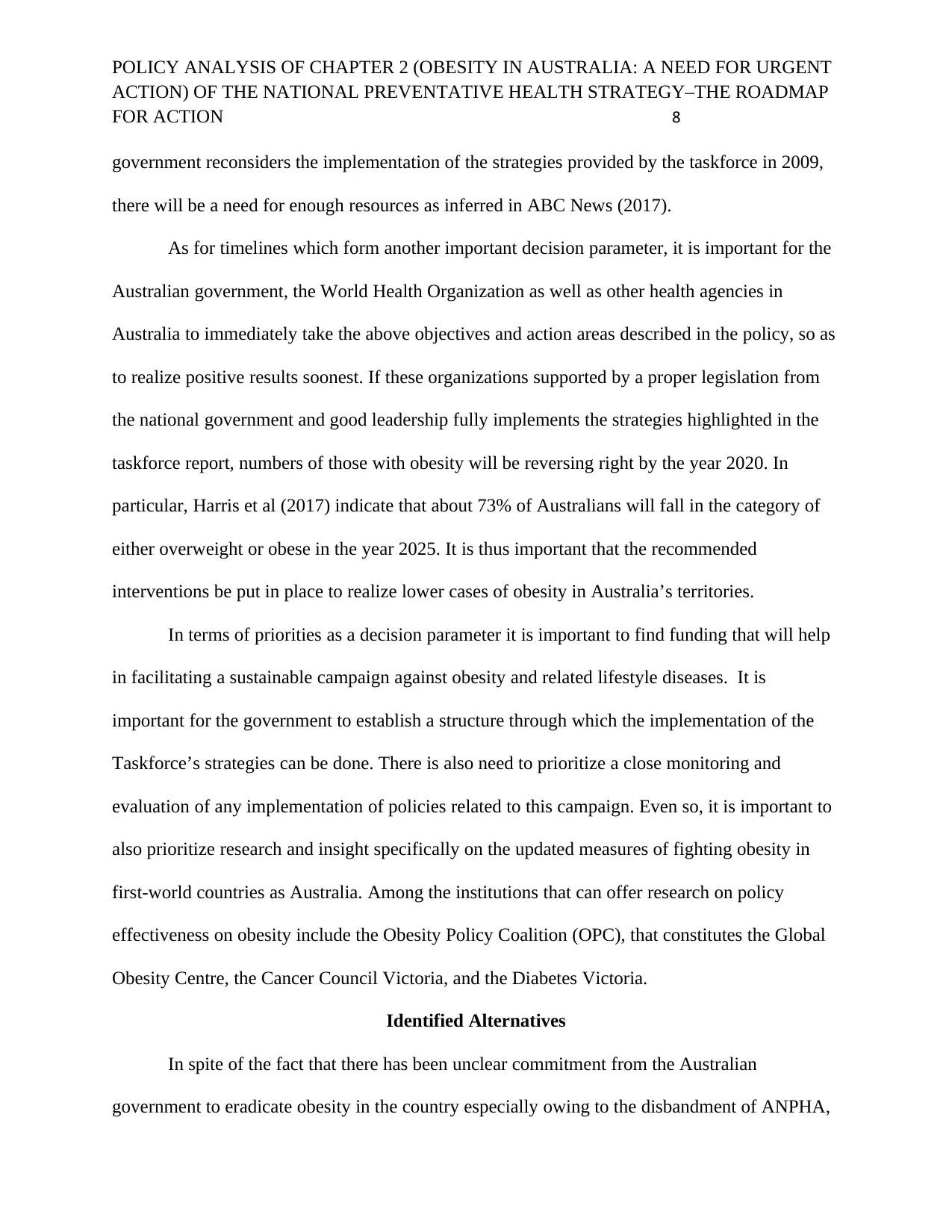
POLICY ANALYSIS OF CHAPTER 2 (OBESITY IN AUSTRALIA: A NEED FOR URGENT
ACTION) OF THE NATIONAL PREVENTATIVE HEALTH STRATEGY–THE ROADMAP
FOR ACTION 8
government reconsiders the implementation of the strategies provided by the taskforce in 2009,
there will be a need for enough resources as inferred in ABC News (2017).
As for timelines which form another important decision parameter, it is important for the
Australian government, the World Health Organization as well as other health agencies in
Australia to immediately take the above objectives and action areas described in the policy, so as
to realize positive results soonest. If these organizations supported by a proper legislation from
the national government and good leadership fully implements the strategies highlighted in the
taskforce report, numbers of those with obesity will be reversing right by the year 2020. In
particular, Harris et al (2017) indicate that about 73% of Australians will fall in the category of
either overweight or obese in the year 2025. It is thus important that the recommended
interventions be put in place to realize lower cases of obesity in Australia’s territories.
In terms of priorities as a decision parameter it is important to find funding that will help
in facilitating a sustainable campaign against obesity and related lifestyle diseases. It is
important for the government to establish a structure through which the implementation of the
Taskforce’s strategies can be done. There is also need to prioritize a close monitoring and
evaluation of any implementation of policies related to this campaign. Even so, it is important to
also prioritize research and insight specifically on the updated measures of fighting obesity in
first-world countries as Australia. Among the institutions that can offer research on policy
effectiveness on obesity include the Obesity Policy Coalition (OPC), that constitutes the Global
Obesity Centre, the Cancer Council Victoria, and the Diabetes Victoria.
Identified Alternatives
In spite of the fact that there has been unclear commitment from the Australian
government to eradicate obesity in the country especially owing to the disbandment of ANPHA,
ACTION) OF THE NATIONAL PREVENTATIVE HEALTH STRATEGY–THE ROADMAP
FOR ACTION 8
government reconsiders the implementation of the strategies provided by the taskforce in 2009,
there will be a need for enough resources as inferred in ABC News (2017).
As for timelines which form another important decision parameter, it is important for the
Australian government, the World Health Organization as well as other health agencies in
Australia to immediately take the above objectives and action areas described in the policy, so as
to realize positive results soonest. If these organizations supported by a proper legislation from
the national government and good leadership fully implements the strategies highlighted in the
taskforce report, numbers of those with obesity will be reversing right by the year 2020. In
particular, Harris et al (2017) indicate that about 73% of Australians will fall in the category of
either overweight or obese in the year 2025. It is thus important that the recommended
interventions be put in place to realize lower cases of obesity in Australia’s territories.
In terms of priorities as a decision parameter it is important to find funding that will help
in facilitating a sustainable campaign against obesity and related lifestyle diseases. It is
important for the government to establish a structure through which the implementation of the
Taskforce’s strategies can be done. There is also need to prioritize a close monitoring and
evaluation of any implementation of policies related to this campaign. Even so, it is important to
also prioritize research and insight specifically on the updated measures of fighting obesity in
first-world countries as Australia. Among the institutions that can offer research on policy
effectiveness on obesity include the Obesity Policy Coalition (OPC), that constitutes the Global
Obesity Centre, the Cancer Council Victoria, and the Diabetes Victoria.
Identified Alternatives
In spite of the fact that there has been unclear commitment from the Australian
government to eradicate obesity in the country especially owing to the disbandment of ANPHA,
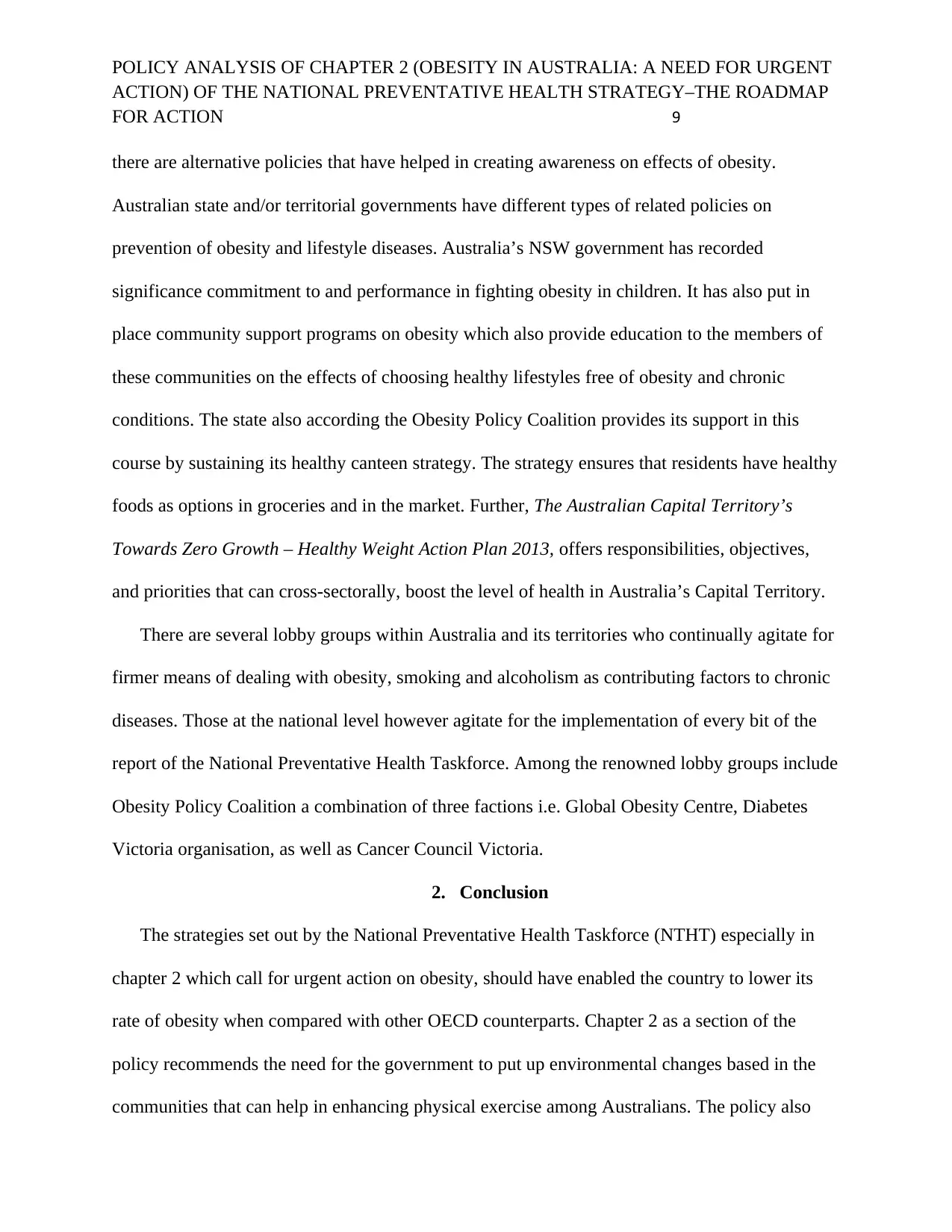
POLICY ANALYSIS OF CHAPTER 2 (OBESITY IN AUSTRALIA: A NEED FOR URGENT
ACTION) OF THE NATIONAL PREVENTATIVE HEALTH STRATEGY–THE ROADMAP
FOR ACTION 9
there are alternative policies that have helped in creating awareness on effects of obesity.
Australian state and/or territorial governments have different types of related policies on
prevention of obesity and lifestyle diseases. Australia’s NSW government has recorded
significance commitment to and performance in fighting obesity in children. It has also put in
place community support programs on obesity which also provide education to the members of
these communities on the effects of choosing healthy lifestyles free of obesity and chronic
conditions. The state also according the Obesity Policy Coalition provides its support in this
course by sustaining its healthy canteen strategy. The strategy ensures that residents have healthy
foods as options in groceries and in the market. Further, The Australian Capital Territory’s
Towards Zero Growth – Healthy Weight Action Plan 2013, offers responsibilities, objectives,
and priorities that can cross-sectorally, boost the level of health in Australia’s Capital Territory.
There are several lobby groups within Australia and its territories who continually agitate for
firmer means of dealing with obesity, smoking and alcoholism as contributing factors to chronic
diseases. Those at the national level however agitate for the implementation of every bit of the
report of the National Preventative Health Taskforce. Among the renowned lobby groups include
Obesity Policy Coalition a combination of three factions i.e. Global Obesity Centre, Diabetes
Victoria organisation, as well as Cancer Council Victoria.
2. Conclusion
The strategies set out by the National Preventative Health Taskforce (NTHT) especially in
chapter 2 which call for urgent action on obesity, should have enabled the country to lower its
rate of obesity when compared with other OECD counterparts. Chapter 2 as a section of the
policy recommends the need for the government to put up environmental changes based in the
communities that can help in enhancing physical exercise among Australians. The policy also
ACTION) OF THE NATIONAL PREVENTATIVE HEALTH STRATEGY–THE ROADMAP
FOR ACTION 9
there are alternative policies that have helped in creating awareness on effects of obesity.
Australian state and/or territorial governments have different types of related policies on
prevention of obesity and lifestyle diseases. Australia’s NSW government has recorded
significance commitment to and performance in fighting obesity in children. It has also put in
place community support programs on obesity which also provide education to the members of
these communities on the effects of choosing healthy lifestyles free of obesity and chronic
conditions. The state also according the Obesity Policy Coalition provides its support in this
course by sustaining its healthy canteen strategy. The strategy ensures that residents have healthy
foods as options in groceries and in the market. Further, The Australian Capital Territory’s
Towards Zero Growth – Healthy Weight Action Plan 2013, offers responsibilities, objectives,
and priorities that can cross-sectorally, boost the level of health in Australia’s Capital Territory.
There are several lobby groups within Australia and its territories who continually agitate for
firmer means of dealing with obesity, smoking and alcoholism as contributing factors to chronic
diseases. Those at the national level however agitate for the implementation of every bit of the
report of the National Preventative Health Taskforce. Among the renowned lobby groups include
Obesity Policy Coalition a combination of three factions i.e. Global Obesity Centre, Diabetes
Victoria organisation, as well as Cancer Council Victoria.
2. Conclusion
The strategies set out by the National Preventative Health Taskforce (NTHT) especially in
chapter 2 which call for urgent action on obesity, should have enabled the country to lower its
rate of obesity when compared with other OECD counterparts. Chapter 2 as a section of the
policy recommends the need for the government to put up environmental changes based in the
communities that can help in enhancing physical exercise among Australians. The policy also
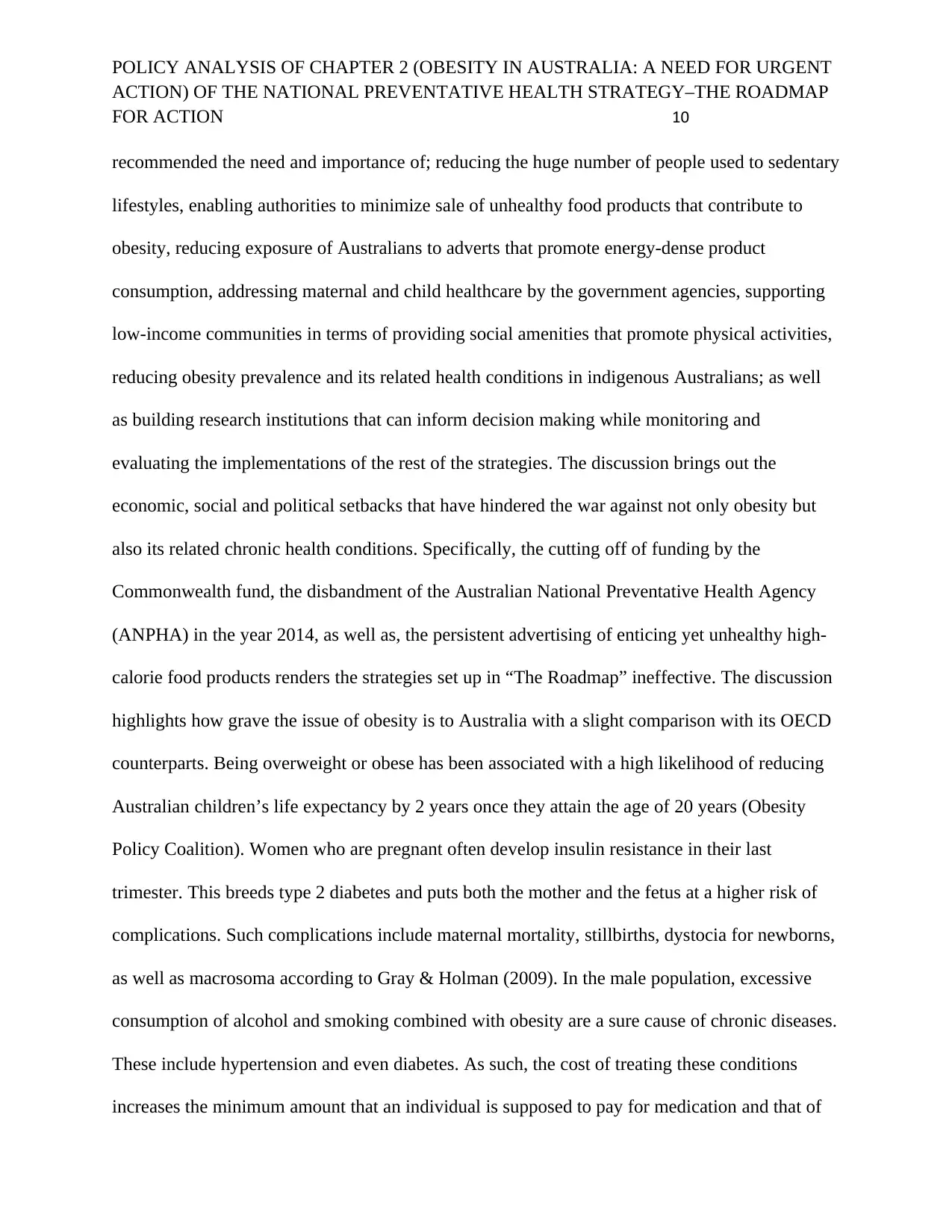
POLICY ANALYSIS OF CHAPTER 2 (OBESITY IN AUSTRALIA: A NEED FOR URGENT
ACTION) OF THE NATIONAL PREVENTATIVE HEALTH STRATEGY–THE ROADMAP
FOR ACTION 10
recommended the need and importance of; reducing the huge number of people used to sedentary
lifestyles, enabling authorities to minimize sale of unhealthy food products that contribute to
obesity, reducing exposure of Australians to adverts that promote energy-dense product
consumption, addressing maternal and child healthcare by the government agencies, supporting
low-income communities in terms of providing social amenities that promote physical activities,
reducing obesity prevalence and its related health conditions in indigenous Australians; as well
as building research institutions that can inform decision making while monitoring and
evaluating the implementations of the rest of the strategies. The discussion brings out the
economic, social and political setbacks that have hindered the war against not only obesity but
also its related chronic health conditions. Specifically, the cutting off of funding by the
Commonwealth fund, the disbandment of the Australian National Preventative Health Agency
(ANPHA) in the year 2014, as well as, the persistent advertising of enticing yet unhealthy high-
calorie food products renders the strategies set up in “The Roadmap” ineffective. The discussion
highlights how grave the issue of obesity is to Australia with a slight comparison with its OECD
counterparts. Being overweight or obese has been associated with a high likelihood of reducing
Australian children’s life expectancy by 2 years once they attain the age of 20 years (Obesity
Policy Coalition). Women who are pregnant often develop insulin resistance in their last
trimester. This breeds type 2 diabetes and puts both the mother and the fetus at a higher risk of
complications. Such complications include maternal mortality, stillbirths, dystocia for newborns,
as well as macrosoma according to Gray & Holman (2009). In the male population, excessive
consumption of alcohol and smoking combined with obesity are a sure cause of chronic diseases.
These include hypertension and even diabetes. As such, the cost of treating these conditions
increases the minimum amount that an individual is supposed to pay for medication and that of
ACTION) OF THE NATIONAL PREVENTATIVE HEALTH STRATEGY–THE ROADMAP
FOR ACTION 10
recommended the need and importance of; reducing the huge number of people used to sedentary
lifestyles, enabling authorities to minimize sale of unhealthy food products that contribute to
obesity, reducing exposure of Australians to adverts that promote energy-dense product
consumption, addressing maternal and child healthcare by the government agencies, supporting
low-income communities in terms of providing social amenities that promote physical activities,
reducing obesity prevalence and its related health conditions in indigenous Australians; as well
as building research institutions that can inform decision making while monitoring and
evaluating the implementations of the rest of the strategies. The discussion brings out the
economic, social and political setbacks that have hindered the war against not only obesity but
also its related chronic health conditions. Specifically, the cutting off of funding by the
Commonwealth fund, the disbandment of the Australian National Preventative Health Agency
(ANPHA) in the year 2014, as well as, the persistent advertising of enticing yet unhealthy high-
calorie food products renders the strategies set up in “The Roadmap” ineffective. The discussion
highlights how grave the issue of obesity is to Australia with a slight comparison with its OECD
counterparts. Being overweight or obese has been associated with a high likelihood of reducing
Australian children’s life expectancy by 2 years once they attain the age of 20 years (Obesity
Policy Coalition). Women who are pregnant often develop insulin resistance in their last
trimester. This breeds type 2 diabetes and puts both the mother and the fetus at a higher risk of
complications. Such complications include maternal mortality, stillbirths, dystocia for newborns,
as well as macrosoma according to Gray & Holman (2009). In the male population, excessive
consumption of alcohol and smoking combined with obesity are a sure cause of chronic diseases.
These include hypertension and even diabetes. As such, the cost of treating these conditions
increases the minimum amount that an individual is supposed to pay for medication and that of
Secure Best Marks with AI Grader
Need help grading? Try our AI Grader for instant feedback on your assignments.
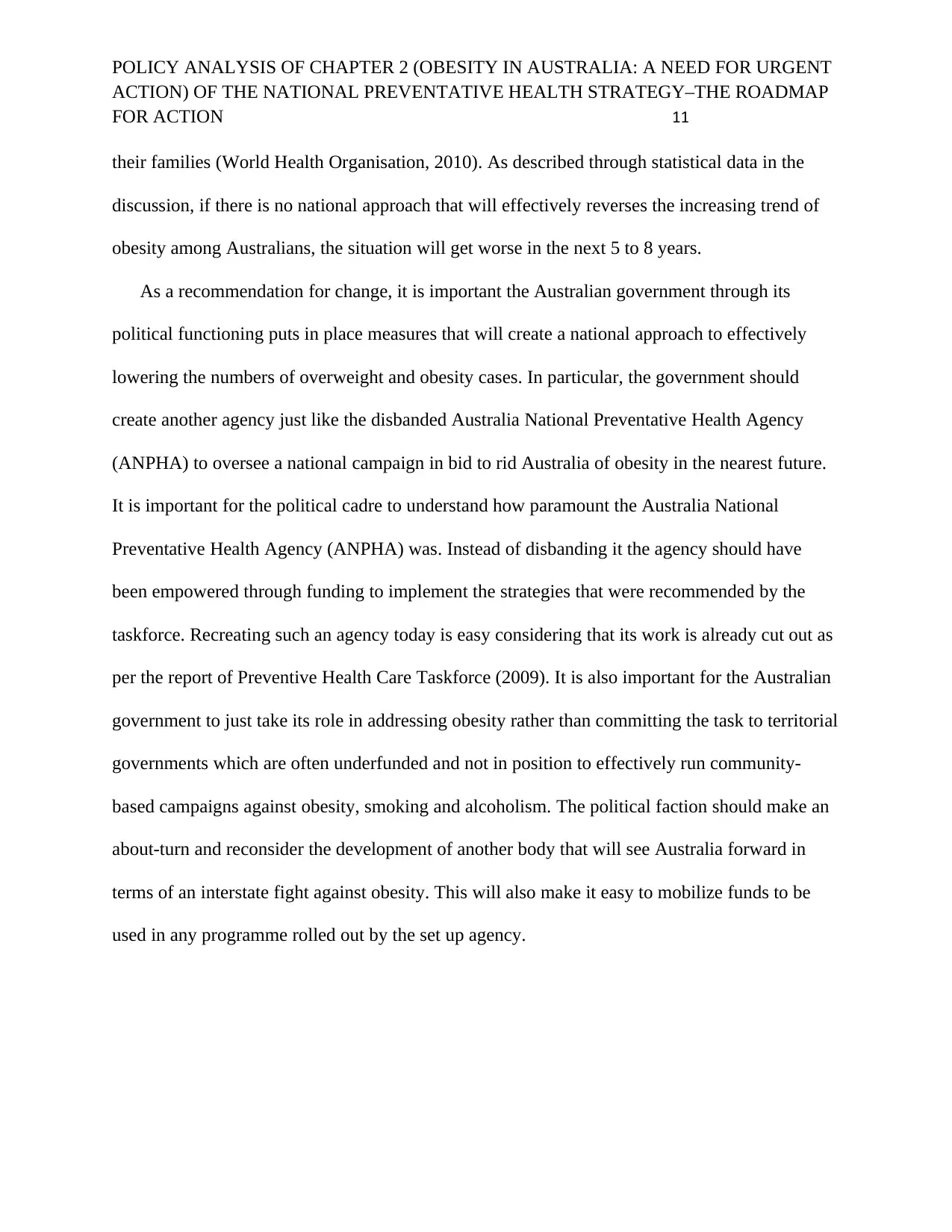
POLICY ANALYSIS OF CHAPTER 2 (OBESITY IN AUSTRALIA: A NEED FOR URGENT
ACTION) OF THE NATIONAL PREVENTATIVE HEALTH STRATEGY–THE ROADMAP
FOR ACTION 11
their families (World Health Organisation, 2010). As described through statistical data in the
discussion, if there is no national approach that will effectively reverses the increasing trend of
obesity among Australians, the situation will get worse in the next 5 to 8 years.
As a recommendation for change, it is important the Australian government through its
political functioning puts in place measures that will create a national approach to effectively
lowering the numbers of overweight and obesity cases. In particular, the government should
create another agency just like the disbanded Australia National Preventative Health Agency
(ANPHA) to oversee a national campaign in bid to rid Australia of obesity in the nearest future.
It is important for the political cadre to understand how paramount the Australia National
Preventative Health Agency (ANPHA) was. Instead of disbanding it the agency should have
been empowered through funding to implement the strategies that were recommended by the
taskforce. Recreating such an agency today is easy considering that its work is already cut out as
per the report of Preventive Health Care Taskforce (2009). It is also important for the Australian
government to just take its role in addressing obesity rather than committing the task to territorial
governments which are often underfunded and not in position to effectively run community-
based campaigns against obesity, smoking and alcoholism. The political faction should make an
about-turn and reconsider the development of another body that will see Australia forward in
terms of an interstate fight against obesity. This will also make it easy to mobilize funds to be
used in any programme rolled out by the set up agency.
ACTION) OF THE NATIONAL PREVENTATIVE HEALTH STRATEGY–THE ROADMAP
FOR ACTION 11
their families (World Health Organisation, 2010). As described through statistical data in the
discussion, if there is no national approach that will effectively reverses the increasing trend of
obesity among Australians, the situation will get worse in the next 5 to 8 years.
As a recommendation for change, it is important the Australian government through its
political functioning puts in place measures that will create a national approach to effectively
lowering the numbers of overweight and obesity cases. In particular, the government should
create another agency just like the disbanded Australia National Preventative Health Agency
(ANPHA) to oversee a national campaign in bid to rid Australia of obesity in the nearest future.
It is important for the political cadre to understand how paramount the Australia National
Preventative Health Agency (ANPHA) was. Instead of disbanding it the agency should have
been empowered through funding to implement the strategies that were recommended by the
taskforce. Recreating such an agency today is easy considering that its work is already cut out as
per the report of Preventive Health Care Taskforce (2009). It is also important for the Australian
government to just take its role in addressing obesity rather than committing the task to territorial
governments which are often underfunded and not in position to effectively run community-
based campaigns against obesity, smoking and alcoholism. The political faction should make an
about-turn and reconsider the development of another body that will see Australia forward in
terms of an interstate fight against obesity. This will also make it easy to mobilize funds to be
used in any programme rolled out by the set up agency.
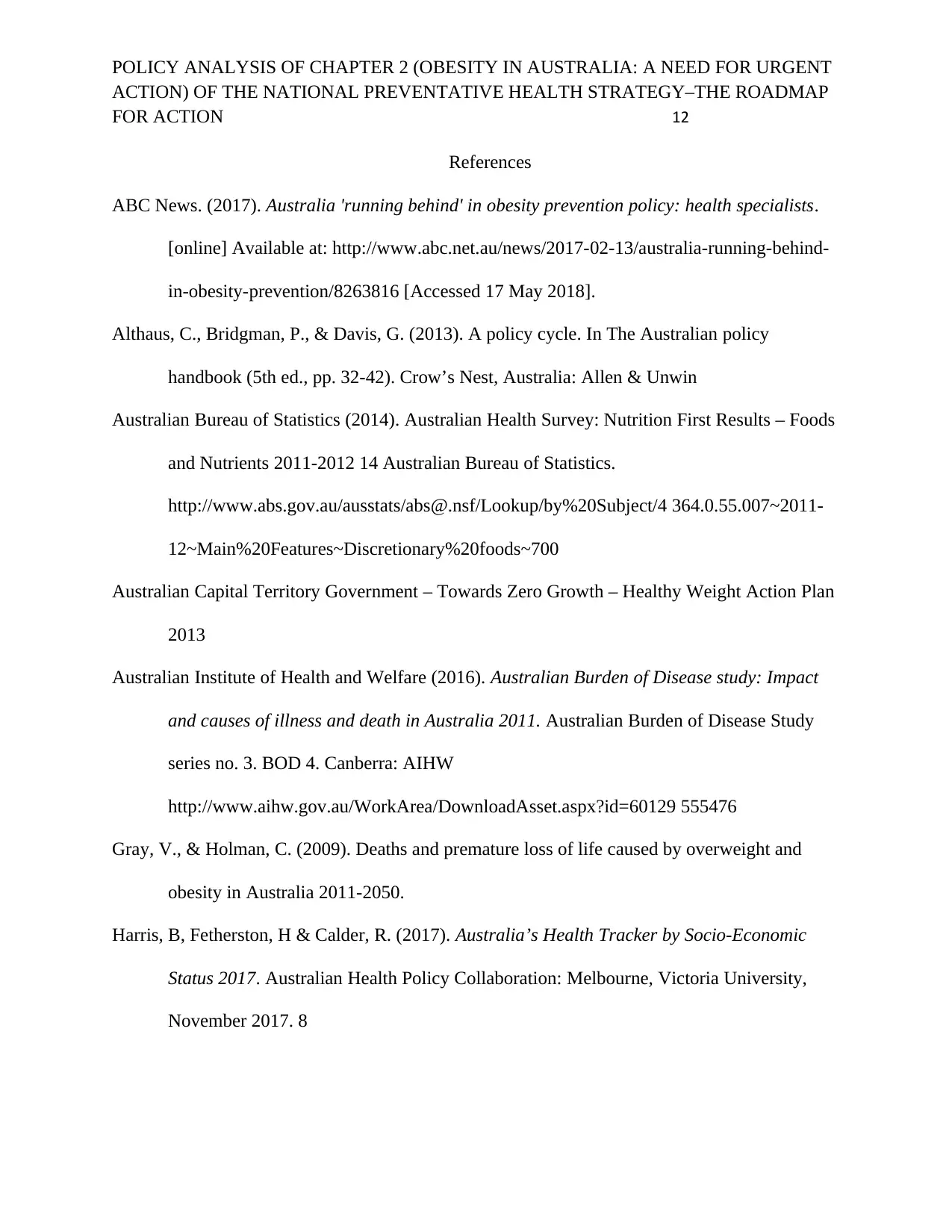
POLICY ANALYSIS OF CHAPTER 2 (OBESITY IN AUSTRALIA: A NEED FOR URGENT
ACTION) OF THE NATIONAL PREVENTATIVE HEALTH STRATEGY–THE ROADMAP
FOR ACTION 12
References
ABC News. (2017). Australia 'running behind' in obesity prevention policy: health specialists.
[online] Available at: http://www.abc.net.au/news/2017-02-13/australia-running-behind-
in-obesity-prevention/8263816 [Accessed 17 May 2018].
Althaus, C., Bridgman, P., & Davis, G. (2013). A policy cycle. In The Australian policy
handbook (5th ed., pp. 32-42). Crow’s Nest, Australia: Allen & Unwin
Australian Bureau of Statistics (2014). Australian Health Survey: Nutrition First Results – Foods
and Nutrients 2011-2012 14 Australian Bureau of Statistics.
http://www.abs.gov.au/ausstats/abs@.nsf/Lookup/by%20Subject/4 364.0.55.007~2011-
12~Main%20Features~Discretionary%20foods~700
Australian Capital Territory Government – Towards Zero Growth – Healthy Weight Action Plan
2013
Australian Institute of Health and Welfare (2016). Australian Burden of Disease study: Impact
and causes of illness and death in Australia 2011. Australian Burden of Disease Study
series no. 3. BOD 4. Canberra: AIHW
http://www.aihw.gov.au/WorkArea/DownloadAsset.aspx?id=60129 555476
Gray, V., & Holman, C. (2009). Deaths and premature loss of life caused by overweight and
obesity in Australia 2011-2050.
Harris, B, Fetherston, H & Calder, R. (2017). Australia’s Health Tracker by Socio-Economic
Status 2017. Australian Health Policy Collaboration: Melbourne, Victoria University,
November 2017. 8
ACTION) OF THE NATIONAL PREVENTATIVE HEALTH STRATEGY–THE ROADMAP
FOR ACTION 12
References
ABC News. (2017). Australia 'running behind' in obesity prevention policy: health specialists.
[online] Available at: http://www.abc.net.au/news/2017-02-13/australia-running-behind-
in-obesity-prevention/8263816 [Accessed 17 May 2018].
Althaus, C., Bridgman, P., & Davis, G. (2013). A policy cycle. In The Australian policy
handbook (5th ed., pp. 32-42). Crow’s Nest, Australia: Allen & Unwin
Australian Bureau of Statistics (2014). Australian Health Survey: Nutrition First Results – Foods
and Nutrients 2011-2012 14 Australian Bureau of Statistics.
http://www.abs.gov.au/ausstats/abs@.nsf/Lookup/by%20Subject/4 364.0.55.007~2011-
12~Main%20Features~Discretionary%20foods~700
Australian Capital Territory Government – Towards Zero Growth – Healthy Weight Action Plan
2013
Australian Institute of Health and Welfare (2016). Australian Burden of Disease study: Impact
and causes of illness and death in Australia 2011. Australian Burden of Disease Study
series no. 3. BOD 4. Canberra: AIHW
http://www.aihw.gov.au/WorkArea/DownloadAsset.aspx?id=60129 555476
Gray, V., & Holman, C. (2009). Deaths and premature loss of life caused by overweight and
obesity in Australia 2011-2050.
Harris, B, Fetherston, H & Calder, R. (2017). Australia’s Health Tracker by Socio-Economic
Status 2017. Australian Health Policy Collaboration: Melbourne, Victoria University,
November 2017. 8

POLICY ANALYSIS OF CHAPTER 2 (OBESITY IN AUSTRALIA: A NEED FOR URGENT
ACTION) OF THE NATIONAL PREVENTATIVE HEALTH STRATEGY–THE ROADMAP
FOR ACTION 13
Holman C, Smith F. (2008). Implications of the obesity epidemic for the life expectancy of
Australians. Report to the Western Australian Institute for Public Health Advocacy.
School of Population Health, University of Western Australia.
Martin, J. (2018). How we get sucked in by junk food specials in supermarkets - Obesity Policy
Coalition. [online] Opc.org.au. Available at:
http://www.opc.org.au/media/opinion/op20180413.html [Accessed 17 May 2018].
Obesity Australia (2015). Obesity: Its impact on Australia and a case for action. No time to
Weight 2. Sydney.
Obesity Policy Coalition (2018). Overweight, Obesity and Chronic Diseases in Australia.
Retrieved from http://www.opc.org.au/downloads/policy-briefs/overweight-obesity-and-
chronic-disease-in-australia.pdf
OECD. (2017). Health at a Glance 2017 – OECD Indicators. , p80. 3
Sacks, G., Martin, J. and Veerman, L. (2016). Australian sugary drinks tax could prevent
thousands of heart attacks and strokes and save 1,600 lives. [online] The Conversation.
Available at: http://theconversation.com/australian-sugary-drinks-tax-could-prevent-
thousands-of-heart-attacks-and-strokes-and-save-1-600-lives-56439 [Accessed 17 May
2018].
Swinburn B, Sacks G, Ravussin E. (2009). Increased food energy supply is more than sufficient
to explain the US epidemic of obesity. American Journal of Clinical Nutrition 2009;
90(6): 1453- 1456.
The Herald/Age (2011). Lateral Economics Index of Australia’s Wellbeing: Final Report.
Available at: https://lateraleconomics.com.au/wpcontent/uploads/2014/02/Fairfax-
Lateral-Economics-Index-ofAustralias-Wellbeing-Final-Report.pdf
ACTION) OF THE NATIONAL PREVENTATIVE HEALTH STRATEGY–THE ROADMAP
FOR ACTION 13
Holman C, Smith F. (2008). Implications of the obesity epidemic for the life expectancy of
Australians. Report to the Western Australian Institute for Public Health Advocacy.
School of Population Health, University of Western Australia.
Martin, J. (2018). How we get sucked in by junk food specials in supermarkets - Obesity Policy
Coalition. [online] Opc.org.au. Available at:
http://www.opc.org.au/media/opinion/op20180413.html [Accessed 17 May 2018].
Obesity Australia (2015). Obesity: Its impact on Australia and a case for action. No time to
Weight 2. Sydney.
Obesity Policy Coalition (2018). Overweight, Obesity and Chronic Diseases in Australia.
Retrieved from http://www.opc.org.au/downloads/policy-briefs/overweight-obesity-and-
chronic-disease-in-australia.pdf
OECD. (2017). Health at a Glance 2017 – OECD Indicators. , p80. 3
Sacks, G., Martin, J. and Veerman, L. (2016). Australian sugary drinks tax could prevent
thousands of heart attacks and strokes and save 1,600 lives. [online] The Conversation.
Available at: http://theconversation.com/australian-sugary-drinks-tax-could-prevent-
thousands-of-heart-attacks-and-strokes-and-save-1-600-lives-56439 [Accessed 17 May
2018].
Swinburn B, Sacks G, Ravussin E. (2009). Increased food energy supply is more than sufficient
to explain the US epidemic of obesity. American Journal of Clinical Nutrition 2009;
90(6): 1453- 1456.
The Herald/Age (2011). Lateral Economics Index of Australia’s Wellbeing: Final Report.
Available at: https://lateraleconomics.com.au/wpcontent/uploads/2014/02/Fairfax-
Lateral-Economics-Index-ofAustralias-Wellbeing-Final-Report.pdf
Paraphrase This Document
Need a fresh take? Get an instant paraphrase of this document with our AI Paraphraser
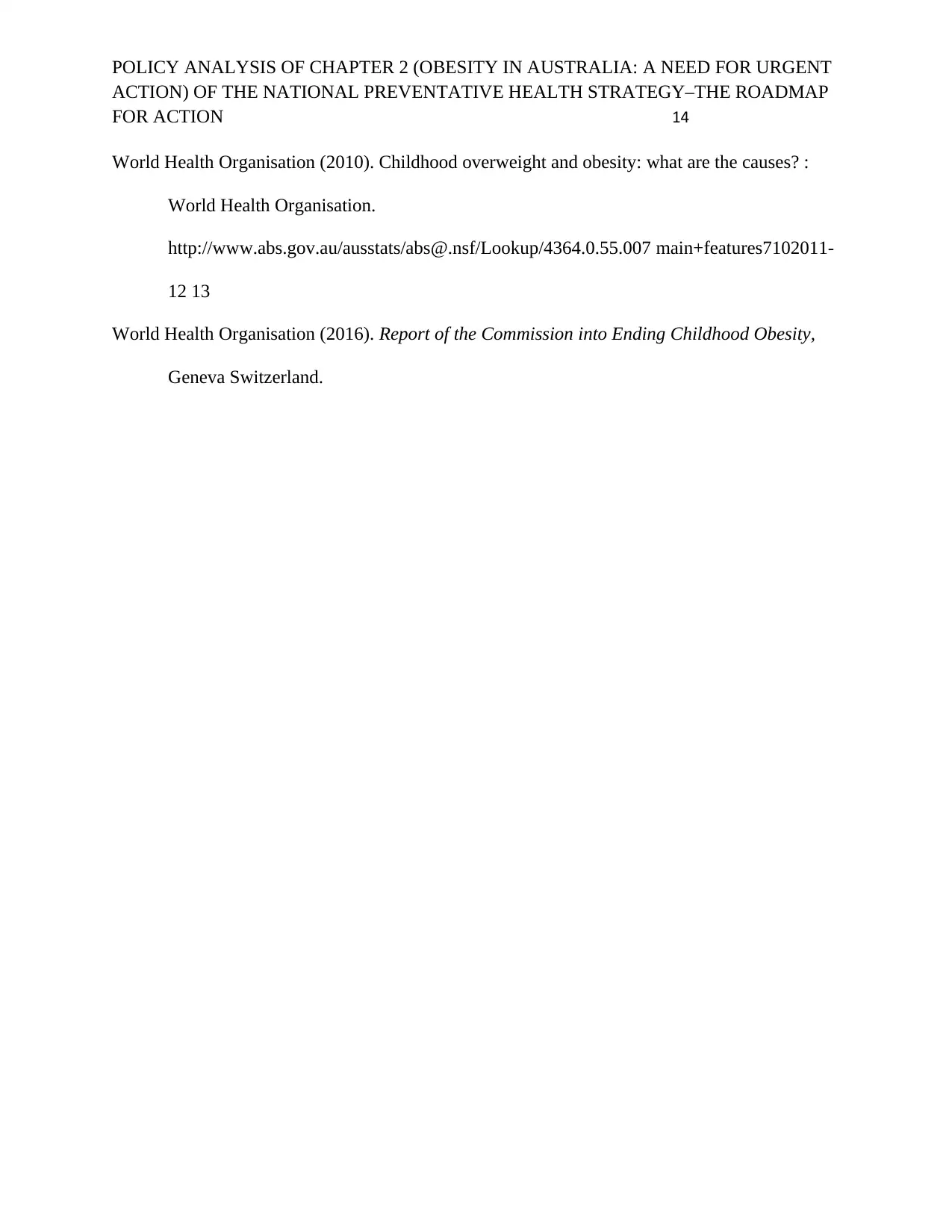
POLICY ANALYSIS OF CHAPTER 2 (OBESITY IN AUSTRALIA: A NEED FOR URGENT
ACTION) OF THE NATIONAL PREVENTATIVE HEALTH STRATEGY–THE ROADMAP
FOR ACTION 14
World Health Organisation (2010). Childhood overweight and obesity: what are the causes? :
World Health Organisation.
http://www.abs.gov.au/ausstats/abs@.nsf/Lookup/4364.0.55.007 main+features7102011-
12 13
World Health Organisation (2016). Report of the Commission into Ending Childhood Obesity,
Geneva Switzerland.
ACTION) OF THE NATIONAL PREVENTATIVE HEALTH STRATEGY–THE ROADMAP
FOR ACTION 14
World Health Organisation (2010). Childhood overweight and obesity: what are the causes? :
World Health Organisation.
http://www.abs.gov.au/ausstats/abs@.nsf/Lookup/4364.0.55.007 main+features7102011-
12 13
World Health Organisation (2016). Report of the Commission into Ending Childhood Obesity,
Geneva Switzerland.
1 out of 14
Related Documents
Your All-in-One AI-Powered Toolkit for Academic Success.
+13062052269
info@desklib.com
Available 24*7 on WhatsApp / Email
![[object Object]](/_next/static/media/star-bottom.7253800d.svg)
Unlock your academic potential
© 2024 | Zucol Services PVT LTD | All rights reserved.





